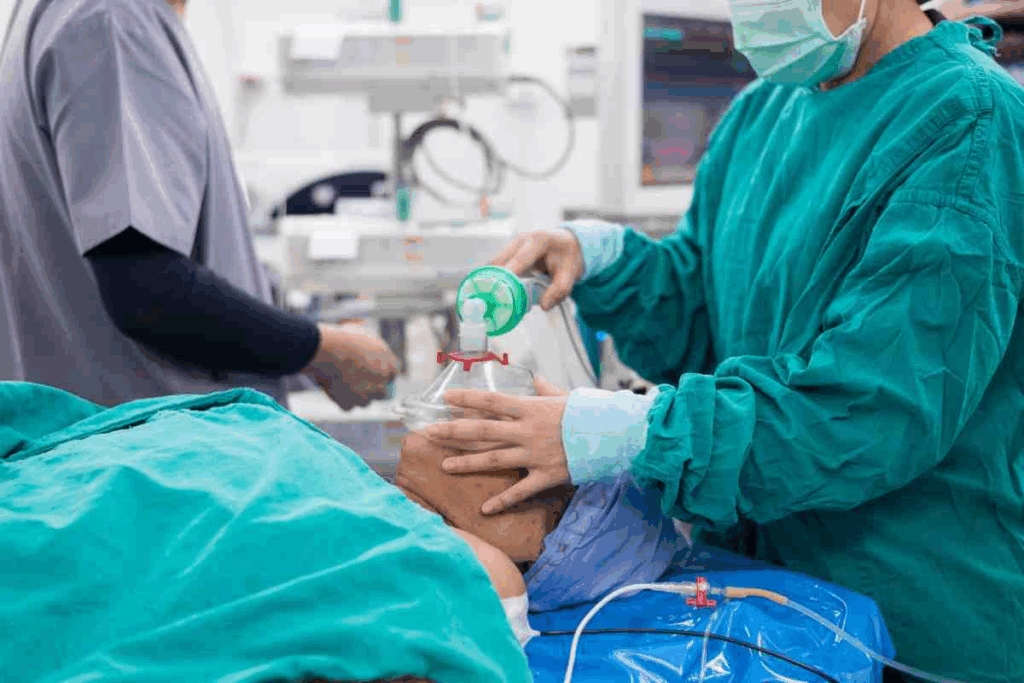Last Updated on October 30, 2025 by Bilal Hasdemir

Anesthesia is key in modern medicine, helping patients feel less pain during surgeries. At Liv Hospital, care is all about the patient. Anesthesia choices are made with each person’s needs in mind.Find out what the difference between local anesthetic and general anesthesia is and their effects.
Local anesthesia numbs a certain area, so patients can stay awake and alert. On the other hand, general anesthesia makes patients unconscious. It’s better for more complicated surgeries.
Choosing between local and general anesthesia changes how patients feel and recover. Knowing how both work, when to use them, and their effects is important. It helps patients make better choices.

Anesthesia is key in modern medicine. It helps with surgeries and procedures, making them less painful for patients. It keeps patients comfortable and safe during operations.
Anesthesia’s main goal is to stop pain during medical treatments. It can make a patient unconscious or numb a body part. This makes surgeries easier and more precise for doctors.
Anesthesia comes in two main types: local and general. Local anesthesia numbs a specific area, letting patients stay awake. General anesthesia makes patients unconscious, best for complex surgeries.
Anesthesia’s history started in the mid-19th century with the first anesthetics. Over the years, it has grown safer and more effective. This is thanks to better drugs and technology.
| Year | Development | Impact |
| 1842 | Crawford Long used diethyl ether as an anesthetic | Marked the beginning of anesthesia in surgery |
| 1846 | Ether anesthesia was publicly demonstrated | Gained acceptance for surgical anesthesia |
| 1884 | Cocaine was introduced as a local anesthetic | Revolutionized local anesthesia practices |
Anesthesia has seen big changes, from ether and chloroform to today’s drugs. It’s a critical part of medicine now. Research keeps making it safer and more effective.

Local and general anesthesia have different roles in medicine. They work in different ways and are used for different procedures. This makes them unique.
Local anesthesia numbs a specific area. This lets patients stay awake and alert for minor surgeries. On the other hand, general anesthesia makes patients unconscious. It’s best for complex surgeries.
Expert says “Anesthesiologists play a key role in choosing the right anesthesia. They consider the patient’s health and the surgery’s needs.”
Patients have different experiences with local and general anesthesia. Local anesthesia lets patients get back to normal quickly. General anesthesia, though, needs more time to recover because it affects the whole body.
“Choosing between local and general anesthesia depends on the patient’s comfort and safety,” the expert said.
It’s important to know the terms in anesthesia. Sedation, analgesia, and anesthesia are often mixed up. But they mean different things. Sedation relaxes the patient, analgesia relieves pain, and anesthesia blocks sensation.
Local anesthesia blocks nerve signals in a specific area. This prevents pain during minor surgeries, dental work, and tests. It keeps patients awake and comfortable.
Local anesthetics stop sodium ions from entering nerve cells. This is key for nerve impulses. By blocking these impulses, they numb the area, stopping pain signals from reaching the brain.
Key aspects of how local anesthetics work include:
Many local anesthetic agents are used in medicine. Some include:
Local anesthesia can be given in different ways. This depends on the procedure and area to be numbed. Common methods are:
Each method is chosen based on the procedure, area, and patient’s health.
General anesthesia makes you completely unconscious, affecting your whole body. It’s needed for big surgeries that would hurt too much for patients to handle.
General anesthetics calm down the brain, making you lose consciousness. “The exact way they work is not fully known,” says an anesthesiologist. “But it’s thought to involve changing how ions and neurotransmitters work.”
These drugs do more than just make you sleep. They also block pain, erase memories, and keep you from moving. This is done with a mix of drugs that target different parts of the anesthetic effect.
There are many kinds of drugs used in general anesthesia, including:
The anesthesiologist is key in giving general anesthesia. They do many things, like:
The American Society of Anesthesiologists says, “The anesthesiologist’s job is more than just giving anesthesia. It’s about keeping the patient safe and comfortable from start to finish.”
Local anesthesia is used in many medical procedures. It numbs specific areas of the body without making you unconscious. This makes it very useful for both patients and doctors.
Local anesthesia is often used in minor surgical procedures. This includes removing small skin lesions or doing vasectomies. It lets patients stay awake and alert, which is safer than general anesthesia.
Using local anesthesia also means patients recover faster. They don’t have to deal with the side effects of general anesthetics.
In dental procedures, local anesthesia is key. It helps dentists do things like fillings, extractions, and root canals without pain. It’s precise, so patients stay comfortable during the whole process.
Local anesthesia is also used in diagnostic procedures and biopsies. It’s important to keep patients comfortable and able to follow instructions. This is true for things like lumbar punctures or biopsies, where patients need to cooperate.
Local anesthesia is great for outpatient procedures because it’s safe and patients recover quickly. They can have surgeries like cataract removal or skin treatments and go home the same day. Often, they don’t need to stay for long after.
In summary, local anesthesia is very versatile. It’s used in many areas, from minor surgeries and dental work to diagnostic tests and outpatient surgeries. It makes patients more comfortable and safe, helping healthcare services run smoothly.
General anesthesia is key in modern surgery. It makes patients unconscious and pain-free. This is vital for many surgeries.
General anesthesia is used for major surgical procedures. These include heart surgeries, brain surgeries, and big bone surgeries. It helps patients feel comfortable during these complex operations.
In emergency surgeries, general anesthesia is vital. It helps patients who need surgery right away. This includes trauma cases and life-threatening conditions.
General anesthesia is also used for pediatric applications. It ensures young patients are comfortable and safe during surgery. Kids need special care because of their unique body needs.
General anesthesia is key for complex and lengthy procedures. It keeps patients comfortable for hours. These surgeries need detailed techniques and require patients to stay calm and pain-free.
General anesthesia is vital in modern medicine. It allows for many surgeries that greatly improve patient lives.
It’s important to know how local and general anesthesia differ in recovery and side effects. This knowledge helps both patients and doctors choose the right anesthesia for surgeries. The recovery time and possible side effects are key factors in making this choice.
Local anesthesia leads to quick recovery with few side effects. Patients can usually go back to their normal activities soon after. A study in the Journal of Clinical Anesthesia found that most patients can leave within an hour after local anesthesia.
Rapid recovery is a big plus of local anesthesia. It’s great for outpatient procedures and minor surgeries.
General anesthesia, though, takes longer to recover from. Patients might need several hours to feel fully awake again. Some may feel drowsy or confused for a while. The American Society of Anesthesiologists says recovery time depends on the anesthetic, surgery length, and patient health.
Local anesthesia is usually safe, but some might feel numbness or tingling where it was injected. Others might have allergic reactions to the anesthetic. These effects are usually mild and short-lived.
General anesthesia can cause more serious side effects. These include nausea and vomiting, sore throat, and confusion or memory loss. These effects can be more severe, affecting older adults or those with health issues.
“The risk of complications from general anesthesia is higher in patients with significant comorbidities or those undergoing complex surgical procedures.”
A study in the British Journal of Anaesthesia stresses the need for careful patient selection and monitoring. This helps reduce these risks.
Choosing between local and general anesthesia is complex. It involves many factors to consider. The decision depends on several important aspects.
The type of surgery affects the choice of anesthesia. Minor surgeries might only need local anesthesia. But, major surgeries often require general anesthesia.
The length of the surgery is also key. Longer surgeries need general anesthesia to keep the patient comfortable.
Each patient’s health and history influence anesthesia choice. Some medical conditions make general anesthesia riskier, so local might be safer. High anxiety levels can also guide the choice towards general anesthesia.
Anesthesiologists must assess risks for each patient and procedure. They consider complications, allergic reactions, and the patient’s health. Safety measures are in place to ensure the chosen anesthesia is safe.
Studies comparing local and general anesthesia are very helpful. They show the advantages and disadvantages of each. This information helps doctors make better choices for their patients.
Studies look at recovery time, patient happiness, and complication rates. This helps decide the best anesthesia for different surgeries.
Different patients need different approaches to anesthesia. Anesthesiologists must think about age, health, and medical history. This ensures safe and effective anesthesia for each patient.
Pediatric patients face unique challenges because of their growing bodies. Anesthesiologists must carefully choose the right anesthetic and dosage. Monitoring vital signs and being ready for complications is key.
“The pharmacokinetics and pharmacodynamics of anesthetic drugs are significantly different in children compared to adults, necessitating careful consideration and adjustment of dosing regimens.”
A study showed the value of tailored anesthesia plans for kids. It found better recovery times and fewer complications.
Elderly patients often have many health issues and take several medications. Careful preoperative assessment is vital to identify risks. The choice between local and general anesthesia depends on the patient’s health and the procedure’s complexity.
| Consideration | Local Anesthesia | General Anesthesia |
| Recovery Time | Generally faster | Can be longer |
| Postoperative Complications | Lower risk | Higher risk, specially in elderly |
| Patient Comfort | Variable, depends on procedure | Typically higher comfort during procedure |
Patients with conditions like diabetes or heart disease need careful management. A thorough preoperative evaluation is essential. For example, heart patients may need closer monitoring during surgery.
Understanding the specific needs of each patient group helps anesthesiologists provide personalized care. This approach improves safety and outcomes.
It’s important to know the difference between local and general anesthesia. Local anesthesia numbs a specific area, letting patients stay awake for minor procedures. General anesthesia, on the other hand, makes patients unconscious, which is needed for complex surgeries.
Choosing between local and general anesthesia depends on several factors. These include the procedure type, patient health, and the anesthesiologist’s opinion. Local anesthesia is often used for minor surgeries, dental work, and tests. General anesthesia is for major surgeries, emergencies, and complex cases.
Both anesthesia types have their own recovery times and side effects. Local anesthesia usually means quicker recovery. General anesthesia needs closer monitoring after the procedure. Knowing these differences helps patients prepare better and make informed choices about their care.
In summary, understanding the difference between local and general anesthesia is key. The right choice is vital for patient safety and comfort during medical procedures.
Local anesthesia numbs a specific area of the body. General anesthesia makes you unconscious and removes all sensation.
For minor surgeries like biopsies or outpatient surgeries, local anesthesia is often used.
Local anesthetics block nerve signals. This numbs the area where the procedure is done.
Side effects of general anesthesia include nausea, vomiting, dizziness, and sore throat.
Yes, patients with pre-existing conditions can get general anesthesia. Their condition is carefully checked and monitored by an anesthesiologist.
An anesthesiologist gives general anesthesia, watches the patient’s vital signs, and ensures their safety during the procedure.
Recovery from local anesthesia is quick. Patients can go back to normal activities soon after. General anesthesia recovery takes longer, with patients feeling drowsy and disoriented.
The choice depends on the procedure type, patient factors, and risk assessment.
The choice for pediatric patients depends on the procedure and their health. General anesthesia is often used for complex or long procedures.
Local anesthetics numb a specific area. General anesthetics make you unconscious and remove all sensation.
No, local anesthesia is not used for major surgeries. It doesn’t provide enough pain relief or muscle relaxation.
Anesthesia has greatly evolved. Advances in medications, techniques, and equipment have improved patient safety and outcomes.
Kim, C. W. (2014). Outcomes of Robotic-Assisted Colorectal Surgery. Seminars in Colon and Rectal Surgery. https://www.sciencedirect.com/science/article/pii/S1091255X23045651
Subscribe to our e-newsletter to stay informed about the latest innovations in the world of health and exclusive offers!
WhatsApp us